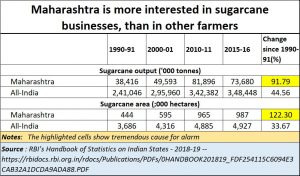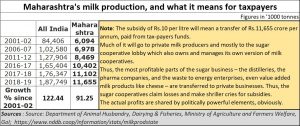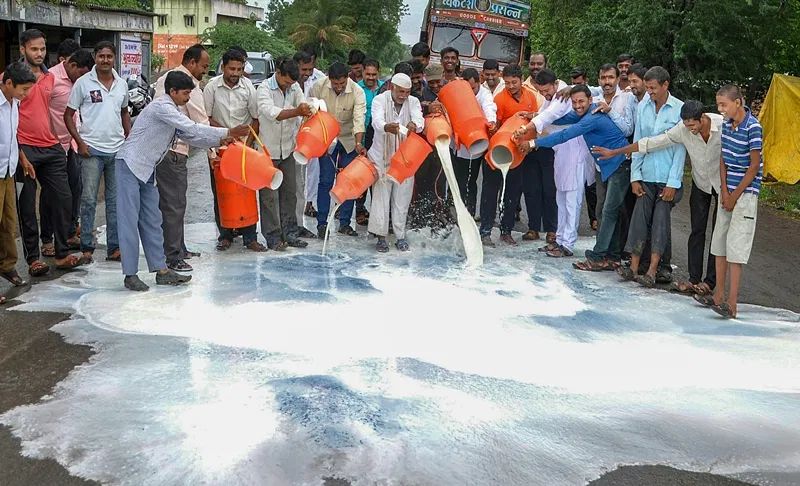https://www.freepressjournal.in/business/policy-watch-how-maharashtras-sugar-lobbies-and-private-milk-producers-plan-to-further-bankrupt-the-state
Maharashtra’s sugar lobbies now support private milk producers for more subsidies
RN Bhaskar – 6 August 2020
 For the past fortnight, Maharashtra’s milk producers have been staging protests on the roads. On several occasions, they highlighted their grievances by pouring out thousands of litres of milk onto the streets. Their clamour: we want the government to subsidise milk prices by Rs.10 a litre (https://www.freepressjournal.in/mumbai/relief-package-for-milk-producers-in-the-pipeline).
For the past fortnight, Maharashtra’s milk producers have been staging protests on the roads. On several occasions, they highlighted their grievances by pouring out thousands of litres of milk onto the streets. Their clamour: we want the government to subsidise milk prices by Rs.10 a litre (https://www.freepressjournal.in/mumbai/relief-package-for-milk-producers-in-the-pipeline).
The reason: the government insists that they pay farmers at least Rs.25 per litre for milk. Gujarat pays a lot more for cows’ milk, while for buffalo’s milk, the price could go up to Rs.50 a litre, depending on fat content. The milk producers (actually, distributors) say that they can pay only Rs.15 a litre. They want the  difference as a subsidy.
difference as a subsidy.
Their demands, however, overlook a simple point. When Gujarat can afford to pay higher prices to farmers without any subsidy from the government, why can’t Maharashtra. Even private sector producers like Hatsun and Nestle do so without any government subsidy. Why should Maharashtra’s producers be given special treatment?
In fact, those who understand how India became the largest producer of milk in India — thanks to the efforts of the late Dr. Verghese Kurien — often forget that the one condition he made was that the farmer ought to be self-sufficient. Subsidies, said Kurien, weaken farmers, not strengthen them. Market mechanisms make them stronger.
The entire milk machinery in Gujarat, backed primarily by the CGMMF and supported by NDDB, is structured on the fundamental premise that the farmer must be the biggest beneficiary of the milk produced. Thus, in Gujarat, a farmer gets almost 80% of the market price of milk. In Maharashtra, he gets barely 50%. So why should any subsidy be given to Maharashtra’s milk distributors?
The end price a customer pays is almost the same across India. The cost of feeding cattle does not vary very much. As former Maharashtra state agriculture minister, Anil Bonde admitted (https://indianexpress.com/article/india/as-procurement-prices-dip-dairy-farmers-look-at-revenue-sharing-model-adopted-by-sugar-sector-to-tide-over-crisis-6533445/), “While a farmer is paid Rs 15 or Rs 16 per litre for milk today, consumers are still paying Rs 40 to 48 per litre. The difference of Rs 24 to 26 per litre is pocketed by both cooperative unions and private dairy companies.”
The fact is that Maharashtra’s milk distributors have a stranglehold over the farmers who produce milk. They have ensured that the milk cooperative movement — represented by the likes of NDDB and GCMMF(AMUL) — does not succeed in this state. The numbers show it (see table). That is why the share of milk procurement and milk marketing in Maharashtra is lower than in any region in India. In fact, milk marketing under the cooperative movement did reasonably well from 2000 to 2010. But then the state milk brand Mahanand got bushwhacked, and private producers (read distributors) took centre stage. Today, unlike Gujarat which sells milk under one brand Amul, or Karnataka which sells under the Nandini brand, Maharashtra has over 30 brands. No wonder, efficiencies of procurement and marketing are missing in Maharashtra.
As these columns have pointed out earlier (http://www.asiaconverge.com/2020/04/milk-subsidies-coronavirus-markets/), subsidies distort the market. They promote the inefficient. And that is why the milk subsidy being demanded is bad in principle and dangerous in precedent.
 But there is a more serious reason why such attempts at subsidies need to be countered. Yet, given the current political scenario, it is possible that the state will buckle. The clout of the sugar cooperatives is intricately linked to their ownership by NCP and Congress politicians (though some cooperatives are onwe4d by the BJP as well). Over the years they have ensured that the clout of the sugar cooperatives continues to increase. This has been at the cost of the rest of the farming community in the state, and even other regions beyond the Marathwada region. The biggest casualty has been the Vidarbha region which has been deprived of water and faces crippling economic growth.
But there is a more serious reason why such attempts at subsidies need to be countered. Yet, given the current political scenario, it is possible that the state will buckle. The clout of the sugar cooperatives is intricately linked to their ownership by NCP and Congress politicians (though some cooperatives are onwe4d by the BJP as well). Over the years they have ensured that the clout of the sugar cooperatives continues to increase. This has been at the cost of the rest of the farming community in the state, and even other regions beyond the Marathwada region. The biggest casualty has been the Vidarbha region which has been deprived of water and faces crippling economic growth.
Study the numbers alongside. Even though it is water starved — water riots are always round the corner – it has allowed the sugar lobby to both increase sugarcane output, as well as the area under sugarcane under cultivation.
This is despite the state accounting for just 20% of its cultivable area being under irrigation, compared to 80% in neighbouring Madhya Pradesh and equally impressive numbers in Gujarat, Andhra Pradesh, and Karnataka.
Successive state governments have been coerced by the sheer political clout that this lobby wields. It controls milk cooperatives too, but these are owned by politicians, and not farmers – definitely not along the same lines as NDDB would like them to be run. They often pay farmers less than 50% of the market price of milk. It is this exploitation of farmers that led the Fadnavis government to finally request NDDB to set up a model cooperative in Nagpur (http://www.asiaconverge.com/2018/07/maharashtra-milk-crisis-farmers-need-get-fair-price-subsidy-not-solution/), and begin procurement of milk at Rs.,26 a litre. Stung by this procurement price benchmark, many milk producers (read distributors) had little option but to increase the price to farmers to Rs.18-22 a litre.
 Then in the face of increased farmer agitation, the state government instructed all milk producers to pay farmers a minimum price of Rs.25, and that is where the seeds of the current agitation lie.
Then in the face of increased farmer agitation, the state government instructed all milk producers to pay farmers a minimum price of Rs.25, and that is where the seeds of the current agitation lie.
So, what does this mean for the state? The answer is simple. The present government owes its very survival to support from the NCP and the Congress. It may, therefore, wilt before the pressure that the milk producers have mounted. This could mean an additional subsidy of almost Rs.12,000 crore annually. That could burden existing taxpayers even further.
Had the bureaucracy been independent, or the judiciary more willing, such a subsidy could have been blocked through three moves.
First, the courts could actually prohibit the state from granting this subsidy, as it would be iniquitous to other stakeholders in the state.
Second, they could ask the state to pass orders to impose a “counter-vailing” import duty of Rs.5 or more for milk coming from states like Karnataka, where too a subsidy is being paid. One state’s subsidy cannot be allowed to ruin the economics of another state.
Third, the courts could compel it to ask sugar cooperatives to restate their books by showing the profits made by their privately held distilleries, pharma companies and dairy businesses. That would immediately make the sugar cooperatives profitable, obviating the need for subsidies. Else, the courts could mandate a significantly higher selling price for molasses, so that the profits remain on the books of the cooperatives.
But the fact is that the present government is vulnerable. The past has shown that the sugar cooperatives can be rapacious and financially profligate. A good example is how the technical committee set up by the Maharashtra government to study the feasibility of advancing bank guarantees to financial weak cooperative sugar mills decided that only four of the 33 mills should get the guarantee (https://indianexpress.com/article/india/33-sugar-mills-apply-for-bank-guarantee-committee-finds-only-4-mills-fit-for-it-6531650/). It also explains why the RBI had to finally step in and take up supervision of the functioning of all state cooperative banks in Maharashtra, many of which were being run by people close to the sugar lobby.
Someone needs to rein in these sugar cooperatives. Their bosses have been making too much of money, often at the expense of common folk. They have robbed banks, diverted water, exploited farmers, and even blocked state development.
But, obviously, the current government is helpless, and the courts appear unwilling to remedy the situation.






































COMMENTS